Jun 14, 2022 | Carson City, coins, dollar, errors, grading, GSA, Morgan
Life can be confusing. One of those confusions is when people do something for reasons that are not obvious. Then when the people were asked why they did not offer any answers.

1882-CC GSA “Grand Snake Morgan Dollar Struck 15% Off Center graded NGC MS 65 (Image courtesy of NGC)
The coin is fascinating in that it looks stunning, survived for so long to be part of the GSA Hoard, and the original owner purchased the coin for $30 in 1972. But that is not what makes this coin a curiosity.
Rather than NGC applying the tamper-evident label that NGC wraps around the GSA holder, NGC placed the entire GSA holder in one of their Mega Holders.
According to NGC’s website, the Mega Holder can hold a coin as large as 180 mm (about 7-inches) in diameter and 28 mm (about 1.1-inches) thick. The NGC holder appears to be three times the size of the GSA holder.
Understandably, a collector would send a coin of this significance to NGC for authentication and grading. But why did NGC have to slab the entire GSA holder? The coin is 38.1 mm in diameter (less than 1-inch) and is in a holder for a coin seven times its size. The coin, which should be the central focus, appears lost.
I tried to ask NGC about their decision to slab the entire GSA holder, and the response I received referred me back to the article that does not discuss the decision. There must be a reason other than “this is what the client wanted.” Even if NGC does not want to answer the question, I want to see the coin in person.
Apr 21, 2021 | Carson City, coins, dollar, silver
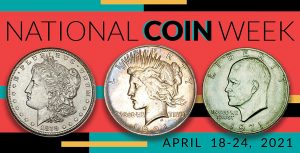 REMINDER:
REMINDER: If you are not a member of the ANA, I will pay your 2021 Gold Membership dues for the
first 25 readers of the Coin Collectors Blog who join during National Coin Week. All you have to do is click
this link and use the Promotion Code
NCW21SB when you check out.
For National Coin Week, all blog posts this will be about large dollar coins. The following is a about the GSA Morgans and the few in my collection.

GSA Sale #3 stepped up its advertising (Image from u/GucciMamba666 on Reddit)
By 1964, the price of silver skyrocketed, making U.S. coins worth less than the metals used to make them. The economics led to a fiscal crisis that had the government rethinking the monetary system.
Silver coins were no longer required to back the U.S. dollar. Along with a law passed by Congress that ordered the General Services Administration to consolidate the government’s real estate usage came the discovery of the largest hoard in history.
Before the GSA started to clean out government-owned buildings, the government knew that they had stored silver coins in a few places. They did not know how many there were and the number of places they were stored.
Congress passed laws that caused over-production and hoarding. The Coinage Act of 1873, also called “The Crime of ’73,” caused a withdrawal of silver from the market. The Bland-Allison Act overturned it in 1878 that required the Treasury to purchase silver from U.S. mines to strike dollars for circulation. Since most silver mining was in Nevada, the Carson City Mint was striking more coins than needed.
The Sherman Silver Purchase Act became law in 1890. It raised the monthly amount of silver the Treasury purchased to 4.5 million ounces per month. The goal was to boost the economy to stem inflation. The law caused more dollars produced in Carson City with no place to distributed them.
To help Great Britain fund their war efforts, the Pittman Act authorized the melting of 350 million silver dollars to be sold at $1.00 per ounce. By the end of the war, over 270 million coins were melted for bullion. It was not enough to deplete the storage. The Act required the Mint to strike new coins with the silver repaid by Britain by 1933.
After several years of cleaning out vaults in different government-owned buildings, the GSA found 2,825,219 Morgan Dollars with the CC mintmark. They also found 112,145 coins from other branch mints. Within those additional coins, the GSA found 84,165 circulated Seated Liberty, Morgan, and Peace Dollars.
The government did not know what to do with the coins. Since they were in Treasury’s vaults, it was up to the Treasury to decide what to do with them. The Treasury’s role changed with the passage of the Federal Reserve Bank Act of 1913 and said that the best they could do was melt the coins. The U.S. Mint did not want the coins back since their job is to produce the coins. The Federal Reserve claimed it had no jurisdiction over the coins since the production and storage occurred before the formation of the Fed.
The GSA was the only agency that had experience liquidating government surplus. But these coins were not ordinary. Many collectors predicted that the sale of these coins would significantly change the numismatic market.

An 1884-O uncirculated Morgan Dollar from the GSA Sale
To sell these coins, the GSA created a special hardpack to hold the circulated coins. The hard-pack would be placed into a box with a certificate of authenticity, and the coins were made available through a mail-bid auction sale.
Coins struck in Carson City would be housed in a plastic case called a lens that said “Carson City” across the top. Other uncirculated coins were placed in a generic case. These coins are called GSA Morgans or GSA Non-CC Morgans.
For circulated coins, the GSA created the Soft Pack. The coins were sealed in mylar with a plastic token and placed in a blue envelope. Collectors refer to these coins as GSA Blue Packs. The GSA did not keep records of the number of Blue Packs sold. However, some have estimated that the GSA created about 100,000 Blue Packs.
-

-
GSA Bluepack Envelope
-

-
1922 Peace Dollar in GSA Bluepack package
-
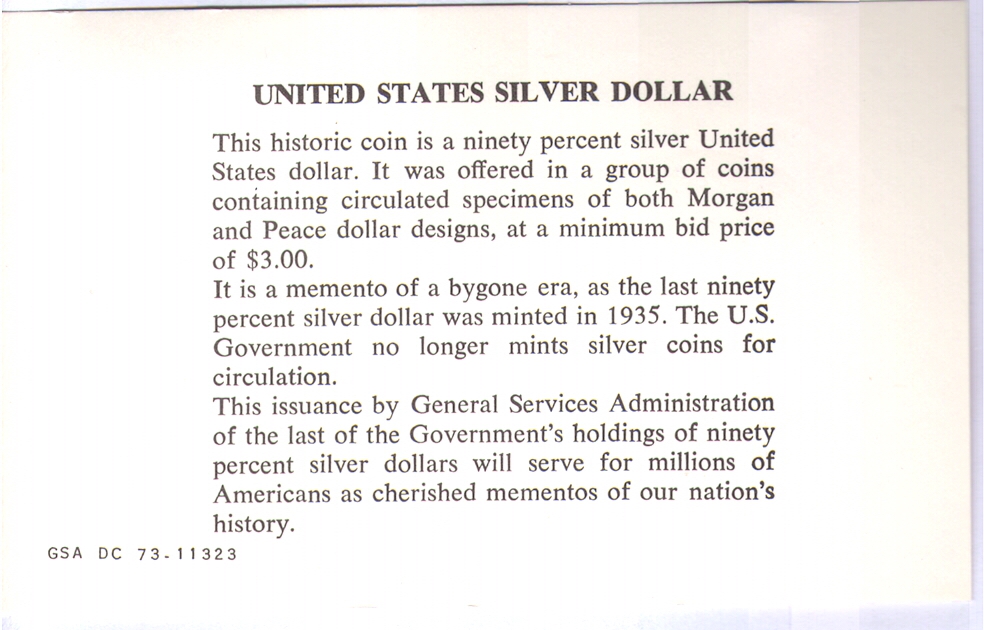
-
GSA Bluepack COA
-

-
GSA Information about the sale of the coins
From 1972 through 1980, the GSA held a series of eight sales. Most were mail-bid type auctions. The last two in 1980 were call-in bidding sales.
My father was cleaning his house, preparing to move into a condo before the pandemic shutdowns and found his GSA Morgan Dollars. He mailed the coins to me for my collection. Three are Carson City dollars, and one struck in New Orleans. My father purchased the coins during the first two GSA sales. He said that he tried to purchase more during the 1980 sales but was outbid.
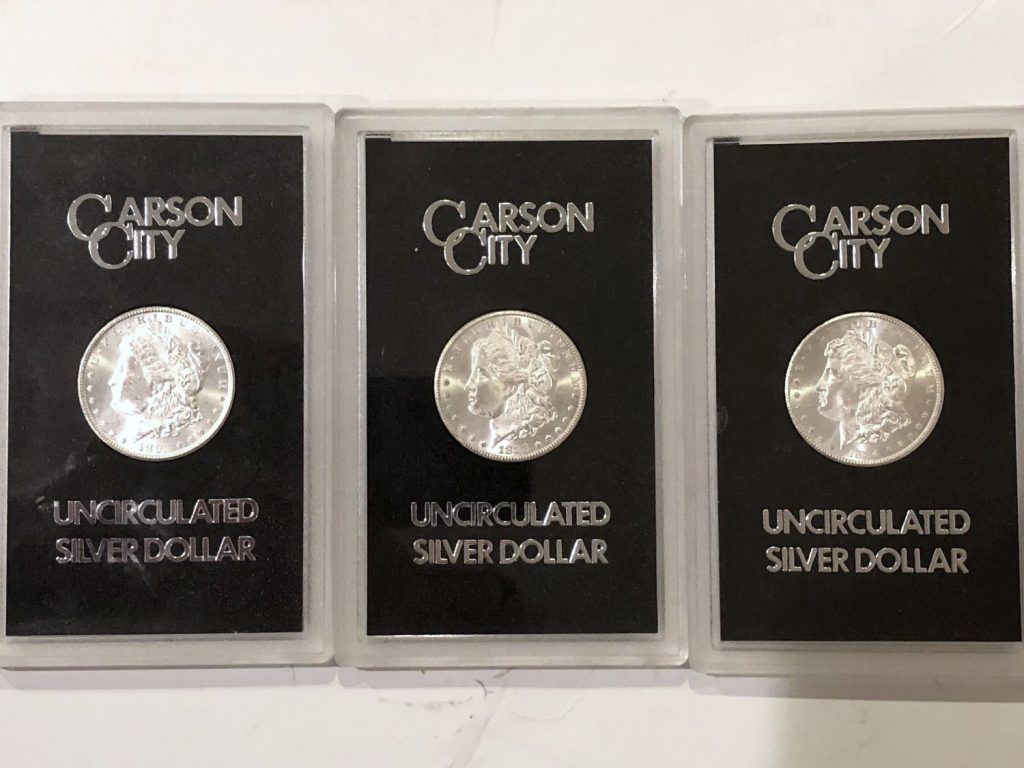
L-to-R: 1882-CC, 1883-CC, and 1884-CC Morgan Dollars in GSA holders
I will eventually send the coins to NGC to have them graded in their original holder. For now, I found an online seller with four empty GSA boxes. Since I have the original Certificates of Authenticity, I will have complete packages.
GSA Preview Movie
Preview from the 1971 GSA movie about the hoard of silver dollars. As you watch the
video, think about what it might have taken for the GSA workers to sort through 3 million coins.
If you like what you read, share, and show your support 
Feb 9, 2020 | Carson City, celebration, commemorative, news, US Mint

Mold used to make the dies for the Carson City Mint Sesquicentennial medal. Image courtesy of the Nevada State Museum.
Although named for Henry Comstock, he did no discover the silver mines in the area. Comstock has the distinction of claiming a stake in the lode before selling his stake for thousands of dollars, an unreasonable sum at the time, and settling in Carson City. Comstock started a few businesses. His brashness and presence lent his name to the discovery.
Comstock is not a hero. He was known for being impatient, careless, lazy, and some accused him of being insane. Comstock committed suicide in 1870, leaving several failed businesses, a failed marriage, and sever debt in his wake.
After the discovery, it was expensive to transport the silver to San Francisco for processing. Nevada politicians lobbied congress for the formation of a branch mint to assay and strike coins. Congress authorized a mint in 1868 for nearby Carson City. The building opened for production in 1870. The Carson City branch mint struck silver and gold coins but in lesser amounts than the other mints making their coins highly collectible and more expensive because of their rarity.
Many consider the coins struck at Carson City to be amongst the most beautiful of all the coins. With the lower production totals, mint employees did not have to rush production, allowing them to create proper strikes. Of course, mistakes happen, and varieties of coins struck at the Carson City Mint are some of the most desirable.
A significant distinction of the coins struck in Carson City is that they bear the “CC” mintmark. It is the only two-character mintmark used on U.S. coins.
Production ended in 1893 with the reduced output from nearby silver mines. The building served as an Assay Office beginning in 1895. It closed following the gold recall of 1933. The State of Nevada purchased the building in 1939.
Today, the building houses the Nevada State Museum, where Coin Press No. 1 continues to strike commemorative half-ounce silver medals every month. There are only four known versions of this coin press in existence and the museum has the only working model.
For the sesquicentennial celebration, the museum struck a commemorative medal for the visitors. Visitors were able to purchase half-ounce silver planchets from the museum’s gift shop and bring them to the Coin Press No. 1 for striking. Because this was an on-demand process, you had to be at the museum to purchase one.
The Mint at Carson City is a symbol of U.S. history. It is where the old west meets modern commerce. From the reports, it sounds like the celebration went well. I hope to be able to visit the museum at some point in time.
And now the news…

February 3, 2020
The huge coin weighs five kilograms (Picture: The Goldsmiths’ Company/SWNS) A £5,000 coin that weighs five kilos and is big enough to eat your dinner off has been produced by the Royal Mint as part of a tradition going back more than 700 years.

→ Read more at
metro.co.uk

February 4, 2020
A giant discovery of nearly 70,000 coins from the Iron Age has set a Guinness World Record for being the largest of its kind discovered in the British Isles. Discovered in January 2012, the collection of 69,347 coins was found in Jersey by metal detector enthusiasts Reg Mead and Richard Miles, British news agency SWNS reports.

→ Read more at
foxnews.com

February 6, 2020
It was born out of Nevada's silver boom. The Carson City Mint coined our money for decades, until 1893 when it closed…later becoming the Nevada State Museum. But museum curator Robert Nylen told me it’s still famous for the coins: "The coins that came out of Carson City.

→ Read more at
ktvn.com

February 6, 2020
(via Kamloops RCMP) Kamloops RCMP has a bit of spare change these days.

→ Read more at
kamloopsmatters.com

February 8, 2020
(Kitco News) U.S. Mint gold coin sales saw a strong recovery in January after the weakest year on record in 2019.

→ Read more at
kitco.com

February 8, 2020
Persistent archaeological treasure hunters have set a new Guinness World Record for the largest coin hoard ever discovered in the British Isles. This treasure story begun in the early 1980s after Reg Mead and Richard Miles read a report about a farmer on Jersey who many years earlier had discovered silver coins in an earthenware pot while pulling out a tree from a hedgerow.

→ Read more at
ancient-origins.net

February 8, 2020
A PORTLAND resident has discovered another 'love token' at Church Ope Cove, prompting theories about what once took place on the sandy shores. Edward Dahl first found a silver sixpence, dating from 1696 during the reign of William III, back in 2018.

→ Read more at
dorsetecho.co.uk

February 9, 2020
It is the second time in history when a coin issued by Latvijas Banka has been recognised the Coin of the Year. The innovative Honey Coin, created by the designer Artūrs Analts, won by a very wide margin, and, quoting the 1 February 2020 press release of the Numismatic News, "the day was sweet as honey" for Latvijas Banka.

→ Read more at
baltictimes.com
Aug 1, 2019 | Carson City, coins, commemorative, history, legislative, US Mint
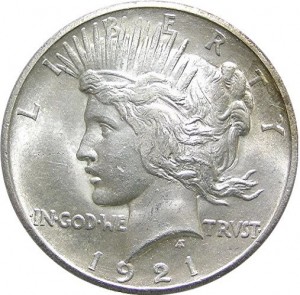
1921-D Peace Dollar
The bill calls for the issue of no more than 500,000 $1 silver coins commemorating the Morgan dollar and the Peace dollar in 2021. If passed, 2021 will mark the 100th anniversary of the end of the Morgan Dollar and the beginning of the Peace Dollar.
Aside from being excited about the issue of the coin, the one line that has caught the interest of collectors is that “it is the sense of Congress that if the Secretary determines it to be feasible and cost effective, the Secretary may mint some of the coins minted under this Act at the Nevada State Museum (formerly a United States Mint facility) located in Carson City, Nevada.”
Although it seems like a good idea, there are a lot of questions whether striking coins in Carson City would be feasible. Since the facility is an active museum, would Nevada be willing to give up a piece of their operations to the federal government? How disruptive would be to the museum’s activities before and after striking the coins?
How would the U.S. Mint strike coins at the museum? While the facility has old coining presses used for demonstrations, they may not be capable of manufacturing modern coinage. Then there is the other equipment involved including an upsetting mill to put an edge on the coin.
The Carson City Mint was built in 1863 to building codes and security standards of the mid-19th century. After the Mint stopped striking circulating coins in 1893, the building became as Assay Office. In 1933, the Great Depression ended its service as an Assay Office. The federal government sold the building to Nevada in 1939. While the Nevada State Museum has updated the building’s security, it is doubtful that it would meet modern U.S. Mint requirements.
Striking coins with the CC mintmark may have an appeal to the collecting community, it might not be feasible and cost-effective.
S. 239: Christa McAuliffe Commemorative Coin Act of 2019
Summary: (Sec. 3) This bill directs the Department of the Treasury to mint and issue not more than 350,000 $1 silver coins in commemoration of Christa McAuliffe, a teacher tragically killed in the Space Shuttle Challenger Disaster.(Sec. 4) The design of the coins shall bear an image and the name of Christa McAuliffe on the obverse side and a design on the reverse side that depicts the legacy of McAuliffe as a teacher.(Sec. 5) Treasury may issue the coins from January 1-December 31, 2021.(Sec. 7) All surcharges received by Treasury from the sale of the coins shall be paid to the FIRST robotics program for the purpose of engaging and inspiring young people, through mentor-based programs, to become leaders in the fields of science, technology, engineering, and mathematics.
Held at the desk. — Jul 10, 2019
Received in the House. — Jul 10, 2019
Message on Senate action sent to the House. — Jul 10, 2019
Passed Senate with amendments by Voice Vote. — Jul 9, 2019
Measure laid before Senate by unanimous consent. — Jul 9, 2019
Senate Committee on Banking, Housing, and Urban Affairs discharged by Unanimous Consent. — Jul 9, 2019
Read twice and referred to the Committee on Banking, Housing, and Urban Affairs. — Jan 28, 2019
The Senate passed the Christa McAuliffe Commemorative Coin Act of 2019 in July. Like the Women’s Suffrage Centennial Commemorative Coin Act (S. 1235) passed in June, the bill is being held at the desk in the House of Representative because of an objection by one of its members.
A source claims that a freshman member of the House has objected to these bills being first passed by the Senate. This member cites Article I Section 7 of the United States Constitution where it says that “All bills for raising revenue shall originate in the House of Representatives.” A spokesperson in the House ’Clerk’s office would not confirm or deny the ’source’s claim.
H.R. 3757: 1921 Silver Dollar Commemorative Coin Act
Referred to the House Committee on Financial Services. — Jul 15, 2019
Aug 4, 2018 | Carson City, coin design, coins, commemorative, commentary, legislative
NOTE: The title is NOT a typographical error. It is a commentary raised by the discussion, below.
With the flurry of legislative action last month, the only bill that I commented on was the American Innovation $1 Coin Act (Public Law No: 115-197) because it was the only one that is the law. The others were just introduced and may not be passed out of committee.
But that has not prevented speculation and discussion about the potential for these potential commemorative coins. Based on the email buzz, the two bills of interest are the Integration of Baseball Commemorative Coin Act (S. 3283 and H.R. 6469) and the Carson City Mint 150th Anniversary Commemorative Coin Act (H.R. 6221).
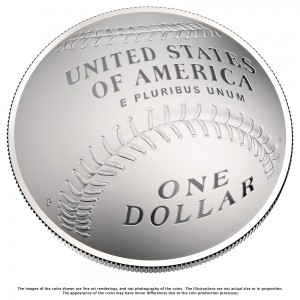
Reverse design of the 2014 Baseball Hall of Fame commemorative (Image courtesy of the U.S. Mint)
For those commentators who cannot read simple English, it says that the design “shall depict a baseball diamond.” Nowhere in that sentence does it say that the coins have to be shaped like the baseball diamond. A depiction and the shape of a coin are two different concepts.
Trying to understand where the idea that the coins would be square, a review of the official statement issued by Sens. Tim Scott (R-SC), Cory Booker (D-NJ), and Rep. Roger Williams (R-TX) as co-sponsors does not mention the shape of the coin.
What might have confused the issue was a report in The Hill that former Montreal Expos and Chicago Cubs legend Andre “The Hawk” Dawson talked about the coin minted in the shape of home plate. While Dawson was a great ballplayer and earned his place in the Baseball Hall of Fame, he is not a member of Congress and, apparently, did not read the bill.
The commentary about the shape does not take into consideration what the bill actually says. Aside from talking about it like it will be the law, it does not take into consideration that the bill is now in committee with less than 90-days to go until the mid-term elections. Without turning this into a political analysis blog post, there will be contention regardless of the outcome of the election. With the late introduction of this bill and the current political environment, the likelihood of this bill passing both chambers before the end of the session is highly unlikely.

Carson City Mint (1866)
Even though the first press used in Carson City is located in the museum, it may not meet the specifications that are required of the U.S. Mint to strike modern commemorative coins. And both the press and building are not owned by the United State government, a fact that would make those who provide oversight of the U.S. Mint’s operations a bit nervous.
While these “what if” questions might make good parlour or message board discussions, allegedly responsible industry journalists and pundits should know better.
Mar 8, 2014 | Carson City, coins, gold, GSA, history, news, rareties, US Mint

One of the cans found as part of the Saddle Ridge Gold Coin Hoard
This is not to say that treasures can only be found in California. As someone who has started a business dealing with collectibles, I have found interesting items at good prices in the most unexpected places. The concept is not to start digging where someone else made their discovery but look for clues to new finds elsewhere. Chances are that the next find will not be the same area.
One of the more interesting aspects of the Saddle Ridge Hoard story is the speculation of where the coins came from and why were they buried in that location. The most entertaining was the story that these coins were stolen in 1901 from the U.S. Mint in San Francisco. Even though it sounds plausible, the details of what would have happened based on historical record does not support this theory.

The old San Francisco Mint building built in 1874
Also, the U.S. Mint is not a bank. It does not save inventory. Records† show that over the years, the U.S. Mint loathes keeping inventory for long periods of time. These sources report a revolving inventory suggesting that only the 1933 Double Eagles may have been kept in the vaults longer than other coins while the policies about gold coins were being settled.
Anticipating the question about the GSA Hoard of silver dollars, those coins were not stored by the U.S. Mint. Those dollars were delivered to the Department of the Treasury to use as backing for silver certificates. The storage areas where the coins were found were either facilities used or leased by Treasury. Coins that were melted under the Pittman Act for sale to the British to help them fund their defense in World War I were coins held by the Treasury. Coins struck to replace the melted coins were then stored in Treasury facilities.
When the General Services Administration (GSA) worked to consolidate and reduce office space in the 1960s, millions of mostly Morgan dollars struck in Carson City were found in several buildings including in storage areas off the historic cash room in the Treasury Building in Washington, D.C. Coins were sold the public by sealed bid over five auction sales between 1972 and 1974 with one final sale in 1980.
Up until 1964, anyone could trade a silver certificate for silver coin at par (e.g., $1 silver certificate for one silver dollar). This ended when silver rose in price making the price of silver more expensive than par value.

One of the 1,427 “Saddle Ridge Hoard” buried treasure gold coins certified by PCGS
Saying that the Saddle Ridge coins were once stolen from the Mint makes for a good headline. Good headlines makes for page views and page views translates into more advertising dollars for those blindly reproducing the erroneous story without checking the facts. Unfortunately, the truth cannot be explained on a bumper sticker or in a sensational headline—but that does not mean I will not try!
See the Saddle Ridge Hoard at Whitman Baltimore
It is being reported that Don Kagin will bring many of the coins in the Saddle Ridge Hoard to the Whitman Expo that will be held March 27-30, 2014 at the Baltimore Convention Center. If you need an excuse to come to Baltimore aside from attending the largest coin and currency show that is not run by the American Numismatic Association, coming to see the Saddle Ridge Hoard before it is broken up and sold later this year.
† A good reference for U.S. Mint statistics is a government-produced publication named Domestic and Foreign Coins Manufactured by the Mints of the United States: 1792-1965. It has been scanned several times and can be found on one of the many archive sites. The problem is that I found only one good scan, and it is not the best, but forgot where I downloaded it from. Printed copies are even more difficult to find.
Credits
- Image of the can of gold coins from the Saddle Ridge Hoard courtesy of Kagin’s.
- Image of the old San Francisco Mint courtesy of Wikipedia.
- Image of the graded eagle courtesy of Professional Coin Grading Service.
Oct 27, 2012 | auction, Carson City, coins, gold, GSA, silver, tokens
How many of you look at the online auctions from the auction houses dedicated to numismatics and feel intimidated?
I can see quite a few virtual hands raised. You probably like coins shows but find the large crowds at some of those shows may also be intimidating. After all, you’re a collector, not an investor or a professional. Sometimes, you can find gems at smaller shows and even smaller auctions.
This is why I was intrigued by an auction notice sent by Stephenson’s Auctioneers and Appraisers from Southampton (Bucks County), Pennsylvania. Judging by their website, Stephenson’s is a local auction company that mainly serves buyers and sellers in its region with and probably has some clientele outside the eastern Pennsylvania area where they are located.
The nice thing about these local auction houses is that they are more accessible than the big houses and they usually have items that are affordable to the average collector. While high-end auctions are fun, if you are buying for yourself, you may not be the type looking to spend six-figures or higher on a coin.
If that is the case and you are in the Bucks County, Pennsylvania area on Friday, November 2, you may want to stop by Stephenson’s and check out their more than 200-lot coin auction that may include “some nice last-minute surprises.”
These are estate auction from the eastern Pennsylvania area. According to the information sent to me, the auction includes a wealth of Morgan silver dollars will be offered, with no fewer than 15 lots comprised of three Morgans each. An uncirculated 1882 Carson City Morgan silver dollar is one of the highlights, and another early example is a trade silver dollar dated 1877. Other antique American coins include Capped Bust half dollars from 1809 and 1838; an 1806 Draped Bust half dollar, and a Seated Liberty half dollar from 1843.
The auction includes two gold pieces. One is a 1914 Indian Head quarter eagle ($2½) and a 1917 $1 gold coin commemorating the slain U.S. President William McKinley.
There are many collectors’ books of coins, including a Washington quarter book (1932-1945) with 24 silver quarters, a Liberty Head nickel book (1883-1912) with 25 nickels, a Standing Liberty book with 10 silver half dollars, a Mercury dime book with 74 silver dimes, including 1921 and 1921-D; and a book consisting of 60 Buffalo nickels. Also included are a Walking Liberty half dollar book with 14 half dollars, a Barber dime book, Roosevelt dime book and Kennedy half dollar book with 59 Kennedy halves, including three 1964 and nine 1965 through 1970 coins. Flying Eagle and Indian Head penny sets will be available, as well as many other books, too numerous to mention.
Desirable non-monetary gold and silver items with both intrinsic and historical value include a boxed set of three 24K gold over .999 silver ingots commemorating the 1973 Triple Crown Winner Secretariat, and a framed sterling silver set titled “The Official Bicentennial Medals of the Thirteen Original States.”
Other lots of interest include two California Gold tokens (1852 and 1853) and an 1860 $5 note issued by the Miners and Planters Bank of North Carolina. Fractional currency, and U.S. Prestige and Olympic Prestige sets.
Auction will be held on Friday, November 2, 2012 at Stephenson’s gallery located at 1005 Industrial Blvd., Southampton, PA 18966. Auction preview is on the auction day from 2-4 p.m. The auction starts at 4 p.m.
For additional information, call Cindy Stephenson at 215-322-6182 or e-mail info@stephensonsauction.com. There will be no Internet bidding for this sale; it is exclusively for gallery, phone and absentee bidders. Visit Stephenson’s online at www.stephensonsauction.com.
If you are in the area, go and have some fun. Who knows, you may find something interesting to bid on!
Some of the items in this auction
-

-
1882 Carson City uncirculated Morgan silver dollar with original GSA box and paperwork. You do not see too many CC Morgans with the original box and paperwork!
-
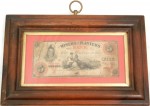
-
1860 $5 note, Miners and Planters Bank of North Carolina.
-

-
Three 24K gold over .999 silver ingots Commemorative of Secretariat.
-

-
Thirteen sterling silver “Official Bicentennial Medals of the Thirteen Original States.”
-
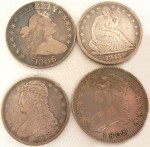
-
Early US coins, including 1809 and 1838 Capped Bust half dollars, 1806 Draped Bust silver dollar, and a, 1843 Seated Liberty half dollar.
-
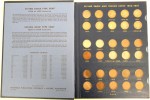
-
Flying Eagle and Indian Head Cent set in a Whitman Album
-

-
1914 Indian Head Quarter Eagle ($2½) gold coin and McKinley Commemorative “Dollar” gold piece.
-
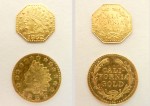
-
1852 and 1853 California Gold Rush tokens
All images courtesy of Stephenson’s Auctioneers.
Sep 8, 2012 | Carson City, cents, coins, errors, fun, gold, silver
I was reading the article “How to follow the money in rare-coin collecting” at MarketWatch.com about the basics of collecting rare coins when I noticed that it pointed to a page withe a slideshow, “The $1 million penny and 7 more famous coins.”
The list has only one “reasonably priced” coin—that is a coin that someone with a little means could afford. It lists the an 1850 Double Eagle at $13,000. That started me to think about the potential to actually owning a few rare collector coins with value and something more align with my tastes. After thinking about this I came up with a list of my “10 Most Desired Coins Within Reason.” In this case, I defined reason as not being so rare that it could only be bought with the help of a good dealer and would not require bidding on it at a once-in-a-lifetime auction. I also set a limit of $5,000 on the price of any coin. I know this may limit the inventory to lower grade for some coins, but those lower grades could give the coin character.
Mostly in denomination and date order, here are Scott’s 10 Most Desired Coins Within Reason:
- 1793 Flowing Hair Chain Cent with AMERI. in Legend is basically amongst the first legal tender coins produced by the U.S. Mint. I know that there was an earlier run of half-dismes, but they were not real production runs. If I am going to produce a list like this, I am going to pick the coin I like and break one of my rules because even at its lowest grade, the coin will probably cost more than $10,000.
- 1909-S Indian Head Cent in Mint State Red. Even though the 1908-S was the first Indian Head cent struck in San Francisco, I am choosing the rarer of the two S-mint Indian Heads in Mint State Red. Of course, this may also break my budget but it would be no fun otherwise.
- 1909-S VDB Lincoln Cent may not be the most expensive Lincoln Cent (the 1914 is), but it is the first of the iconic series and part of the controversy started because of the “V.D.B” initials on the reverse. Fortunately, I already own one graded as VF-30BN by NGC.
- 1955 Double Die Obverse Lincoln Cent is the coin that sparked the interest in error collecting. It is remarkable to think that one coin, a mistake, created a new segment of the hobby. For me, I already own one graded AU-58BN by NGC that I really like.
- 1937-D 3-Legged Buffalo is a very cool coin. Aside that the Buffalo Nickel is one of my favorite coin designs, there is something intriguing about the story behind this coin. Fortunately, the one I own was graded VF-25 by NGC and the last of the ones I already own on this list.
- 1917 Type 1 Standing Liberty Quarter is a compromise because the 1916 would be too expensive. In order to add a type 1 design (with breast exposed), the 1917 version is more reasonably priced in higher grades.
- 1921 Walking Liberty Half Dollar would be the coin I would point to on this list as being my favorite design. For me, only the Saint-Gaudens Double Eagle come close to Adolph Weinman’s design. It should not surprise anyone that Weinman was one of Saint Gaudens’ students. The 1921 half dollars were almost an afterthought as the U.S. Mint was rushing to produce silver dollars and the 1921 fits the criteria to buy one in higher grades.
- 1878-CC Morgan Dollar in the GSA Holder because it is interestingly historic. The Morgan Dollar was authorized by the Bland-Allison Act that required the Treasury Department to buy silver from western mines and put them into circulation as silver dollars. It was passed after the Coinage Act of 1873, sometimes referred to as the “Crime of ’73,” demonetized silver and set the standard for gold as the backing of the national currency. Not only do you get the collectible from a western state near a western mine, but the GSA Holder is from the historic sales of the 1970s after the GSA started pulling coins out of storage in buildings long forgotten.
- 1908 Indian Head Gold Half-Eagle because if you make a list like this, there has to be some gold on it. If I am going to do a gold coin, I want the only coin whose design is incuse to the coin. Bela Pratt Lyon’s incuse Indian Head design is unique and nicely available in its first year of mintage.
- 1907 No Motto Saint Gaudens Double Eagle because this list cannot be complete with the other of the two most iconic designs ever made for a circulating coin. Since 1907 is the first year, this is the most affordable of the three types made that year and is more available than the high-relief versions.
Do you have a similar list? Add it to the comments below.
Apr 24, 2007 | ANA, Carson City, coins, dollar, shows
Morgan Dollars were not popular during the time they were being struck by the US Mint. They were not considered particularly beautiful and most people outside of a few western states preferred to carry paper currency. But the Bland-Allison Act of 1878 and the Sherman Silver Purchase Act of 1890 prescribed large purchases of silver from western mines and the minting of silver coinage to back silver certificates. This continued until the Panic of 1893 when the decline in the economy created a run on the gold supply. Then many were melted as a result of the silver recall prescribed in the Pittman Act while others were stored in Treasury buildings to be discovered by the General Services Administration in the 1960s.
Since their last mintage in 1921, the dollars designed by Mint Engraver George T. Morgan did not enjoy wide popularity until the GSA Hoard. Of the Morgan Dollars that hold the mystique are the ones struck at the Carson City Mint. Situation near the famous Comstock Lode, the Carson City Mint. Most CC minted dollars were amongst the lowest minted of the series. The highest mintage was the 1890-CC where over 2.3 million were struck.
Finding nice, affordable examples of CC mint Morgan Dollars can be difficult. Those of us on a budget compromise and purchase cleaned or polished coins in order to own at least one example. But when I had the opportunity to buy a nice, “common” CC coin for a good price, I could not resist.
 I was walking the floor at the American Numismatic Association National Money Show in Charlotte and found a dealer selling quite a few ungraded Morgan Dollars. As I searched through several boxes, I came across a nice 1878-CC Morgan Dollar (2.2 million minted). The 2×2 holder the coins was in said the coin was in Almost Uncirculated. It was a nice, clean coin with some mint luster showing a great strike. I was sure that if it was slabbed it would have graded higher than what was written on the holder. It was priced as if it was an Extra Fine coin.
I was walking the floor at the American Numismatic Association National Money Show in Charlotte and found a dealer selling quite a few ungraded Morgan Dollars. As I searched through several boxes, I came across a nice 1878-CC Morgan Dollar (2.2 million minted). The 2×2 holder the coins was in said the coin was in Almost Uncirculated. It was a nice, clean coin with some mint luster showing a great strike. I was sure that if it was slabbed it would have graded higher than what was written on the holder. It was priced as if it was an Extra Fine coin.
I could not resist… I bought my first no-problem CC Morgan Dollar!
It is a beautiful coin that looks great in the blue album shining next to my other Morgan Dollars.
Feb 8, 2007 | Carson City, coins, dollar, Morgan, US Mint
There is something magical about the Morgan Dollar. It is the only coin that seems to remind us of the Manifest Destiny as the country expanded across the Great Plains to the Pacific Ocean. It brings up images of the Old West where people moved to make a better life looking for gold and silver or making money from those who have struck it rich. Sure this is a romantic view and does not take into consideration the plight of the Native American nations, but it ties into the fascination there has been with the west of the 19th Century.
The Comstock Lode was the greatest discovery of silver. So much silver was discovered that it was causing the price of silver was declining. To protect the financial interests of the mine owners and allegedly the nation’s economy, congress passed the Bland-Allison Act of 1879 to order the US Mint to buy the silver evacuated from the mines. The law required the Mint to produce 90-percent silver coins for circulation using that silver. The result was an over production of silver that would have repercussions for years to come.
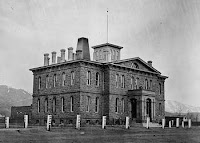 Virginia City was the hub of the region, many deals and other favors lead to the building of an assay office then a full branch mint in nearby Carson City. Its history is an example of how things worked in the 19th century. The cornerstone for this branch mint was laid in September 1865 and was opened to strike coins in 1870. When the Morgan Dollar began its run in 1878, this branch mint would strike far more coins than necessary.
Virginia City was the hub of the region, many deals and other favors lead to the building of an assay office then a full branch mint in nearby Carson City. Its history is an example of how things worked in the 19th century. The cornerstone for this branch mint was laid in September 1865 and was opened to strike coins in 1870. When the Morgan Dollar began its run in 1878, this branch mint would strike far more coins than necessary.
As the Mint purchased the required amount of silver and struck coins, the extra Morgan Dollars were bagged and placed into storage. These bags were transported to different government buildings including the Department of the Treasury in downtown Washington, DC. These coins were discovered in the 1960s by the General Services Administration (GSA) when they were cleaning out old government buildings in Carson City for sale and the Treasury building for refurbishing. The GSA sale of these Carson City dollars in special holders caught the imagination of the public.
The stories of the CC Mint is legendary. Like a lot of people, when I started to collect Morgan Dollars, I thought the cost of purchasing examples of these CC minted dollars was a bit out of my price range. Over the last few years, I have been looking for an affordable (under $100) nice looking coin. It would have to be at least in Very Fine condition with some mint luster, but at least worth the grade.
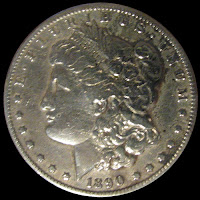
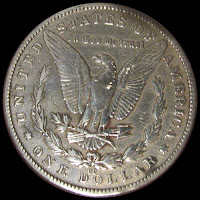 I finally found one! The 1890-CC Morgan Dollar is not worth a lot in comparison to other CC mint Morgan Dollars. But it is still a nice coin. But when I was able to find a Very Fine 1890-CC Morgan Dollar for under $100, I had to make this purchase. It is a nice coin with a little shine that suggests it was dipped a long time ago. But the elements are nice and the CC mint mark on the reverse is very clear.
I finally found one! The 1890-CC Morgan Dollar is not worth a lot in comparison to other CC mint Morgan Dollars. But it is still a nice coin. But when I was able to find a Very Fine 1890-CC Morgan Dollar for under $100, I had to make this purchase. It is a nice coin with a little shine that suggests it was dipped a long time ago. But the elements are nice and the CC mint mark on the reverse is very clear.
While uncirculated coins are very beautiful, circulated coins have a history. What events did this coin see? Whose hands has this coin passed through? Was this coin used in Deadwood, South Dakota? Was it once handled by Buffalo Bill Cody? Or Teddy Roosevelt? I may not know this coin’s history, but it is fun to imagine while admiring its beauty.











 → Read more at
→ Read more at 

















